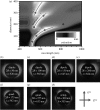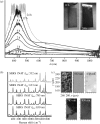Surface-enhanced Raman scattering biomedical applications of plasmonic colloidal particles
- PMID: 20462878
- PMCID: PMC2943889
- DOI: 10.1098/rsif.2010.0125.focus
Surface-enhanced Raman scattering biomedical applications of plasmonic colloidal particles
Abstract
This review article presents a general view of the recent progress in the fast developing area of surface-enhanced Raman scattering spectroscopy as an analytical tool for the detection and identification of molecular species in very small concentrations, with a particular focus on potential applications in the biomedical area. We start with a brief overview of the relevant concepts related to the choice of plasmonic nanostructures for the design of suitable substrates, their implementation into more complex materials that allow generalization of the method and detection of a wide variety of (bio)molecules and the strategies that can be used for both direct and indirect sensing. In relation to indirect sensing, we devote the final section to a description of SERS-encoded particles, which have found wide application in biomedicine (among other fields), since they are expected to face challenges such as multiplexing and high-throughput screening.
Figures








Similar articles
-
Exploring Reliable and Efficient Plasmonic Nanopatterning for Surface- and Tip-Enhanced Raman Spectroscopies.Int J Mol Sci. 2023 Nov 10;24(22):16164. doi: 10.3390/ijms242216164. Int J Mol Sci. 2023. PMID: 38003354 Free PMC article. Review.
-
Recent advances in non-plasmonic surface-enhanced Raman spectroscopy nanostructures for biomedical applications.Wiley Interdiscip Rev Nanomed Nanobiotechnol. 2022 Jul;14(4):e1795. doi: 10.1002/wnan.1795. Epub 2022 Apr 1. Wiley Interdiscip Rev Nanomed Nanobiotechnol. 2022. PMID: 35362261 Review.
-
Engineered Two-Dimensional Nanostructures as SERS Substrates for Biomolecule Sensing: A Review.Biosensors (Basel). 2023 Jan 6;13(1):102. doi: 10.3390/bios13010102. Biosensors (Basel). 2023. PMID: 36671937 Free PMC article. Review.
-
Surface-enhanced Raman scattering on colloidal nanostructures.Adv Colloid Interface Sci. 2005 Nov 30;116(1-3):45-61. doi: 10.1016/j.cis.2005.04.007. Epub 2005 Oct 6. Adv Colloid Interface Sci. 2005. PMID: 16213453 Review.
-
Intracellular and Cellular Detection by SERS-Active Plasmonic Nanostructures.Chembiochem. 2019 Oct 1;20(19):2432-2441. doi: 10.1002/cbic.201900191. Epub 2019 Jul 2. Chembiochem. 2019. PMID: 30957950 Review.
Cited by
-
Miniaturized Raman Instruments for SERS-Based Point-of-Care Testing on Respiratory Viruses.Biosensors (Basel). 2022 Aug 2;12(8):590. doi: 10.3390/bios12080590. Biosensors (Basel). 2022. PMID: 36004986 Free PMC article. Review.
-
Cellular imaging by targeted assembly of hot-spot SERS and photoacoustic nanoprobes using split-fluorescent protein scaffolds.Nat Commun. 2018 Feb 9;9(1):607. doi: 10.1038/s41467-018-03046-w. Nat Commun. 2018. PMID: 29426856 Free PMC article.
-
Point-of-care testing in the early diagnosis of acute pesticide intoxication: The example of paraquat.Biomicrofluidics. 2018 Jan 19;12(1):011501. doi: 10.1063/1.5003848. eCollection 2018 Jan. Biomicrofluidics. 2018. PMID: 29430271 Free PMC article. Review.
-
A Review of Distributed Optical Fiber Sensors for Civil Engineering Applications.Sensors (Basel). 2016 May 23;16(5):748. doi: 10.3390/s16050748. Sensors (Basel). 2016. PMID: 27223289 Free PMC article. Review.
-
Fundamentals of Biosensors and Detection Methods.Adv Exp Med Biol. 2022;1379:3-29. doi: 10.1007/978-3-031-04039-9_1. Adv Exp Med Biol. 2022. PMID: 35760986
References
-
- Abalde-Cela S., Ho S., Rodriguez-Gonzalez B., Correa-Duarte M. A., Alvarez-Puebla R. A., Liz-Marzan L. M., Kotov N. A. 2009. Loading of exponentially grown LBL films with silver nanoparticles and their application to generalized SERS detection. Angew. Chem. Int. Ed. 48, 5326–5329. (10.1002/anie.200901807) - DOI - PubMed
-
- Aizpurua J., Bryant G. W., Richter L. J., García De Abajo F. J., Kelley B. K., Mallouk T. 2005. Optical properties of coupled metallic nanorods for field-enhanced spectroscopy. Phys. Rev. B 71, 1–13.
Publication types
MeSH terms
LinkOut - more resources
Full Text Sources
Other Literature Sources
Miscellaneous

